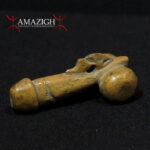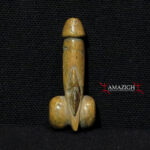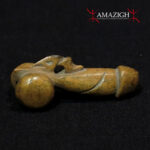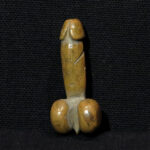Ancient Roman Phallus Amulet – Fascinus – III-V century A.D. – From Viminacium
299,95€
Precious antique material grams 6.9 (0.24 oz.); cm. 4.4 high (1.73 “).
In ancient Roman religion and magic, the Fascinus or Fascinum was the embodiment of the divine phallus. The word can refer to phallus effigies and amulets, and to the spells used to invoke his divine protection of him. Pliny calls it a medicus invidiae, a “doctor” or remedy for envy (invidia, a “looking upon”) or the evil eye.
Phallic charms, often winged, were ubiquitous in Roman culture, appearing as objects of jewelery such as pendants and finger rings, relief carvings, lamps, and wind chimes (tintinnabula).
Fascinus was thought particularly to ward off evil from children, mainly boys, and from conquering generals.
Viminacium was a major city (provincial capital) and military camp of the Roman province of Moesia (today’s Serbia), and the capital of Moesia Superior.
The city dates back to the 1st century AD, and at its peak it is believed to have had 40,000 inhabitants, making it one of the biggest cities in the Balkans of that time. It lies on the Roman road Via Militaris. Today, the archaeological site contains remains of temples, streets, squares, amphitheaters, palaces, hippodromes and Roman baths.
m16
- Additional information
Additional information
| Weight | 150 g |
|---|









